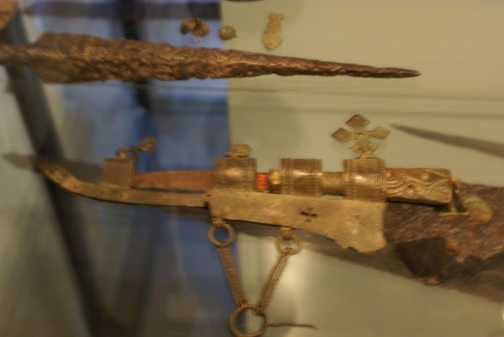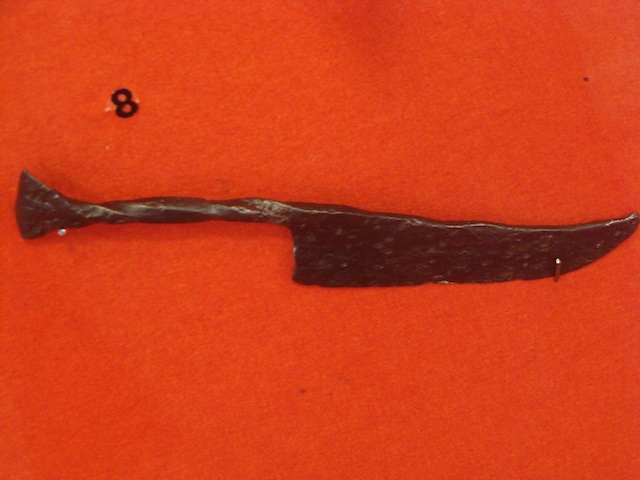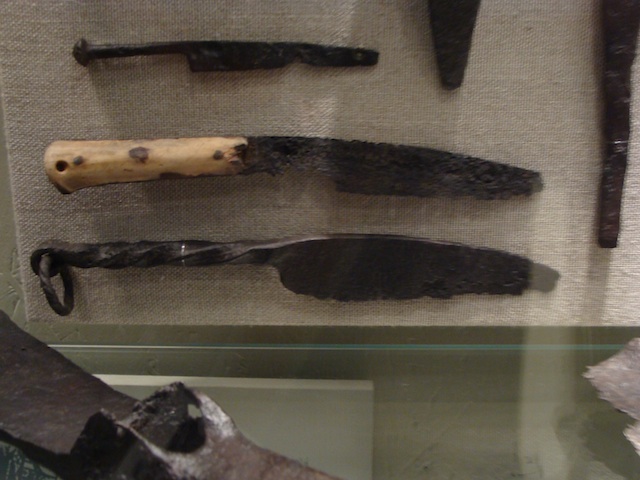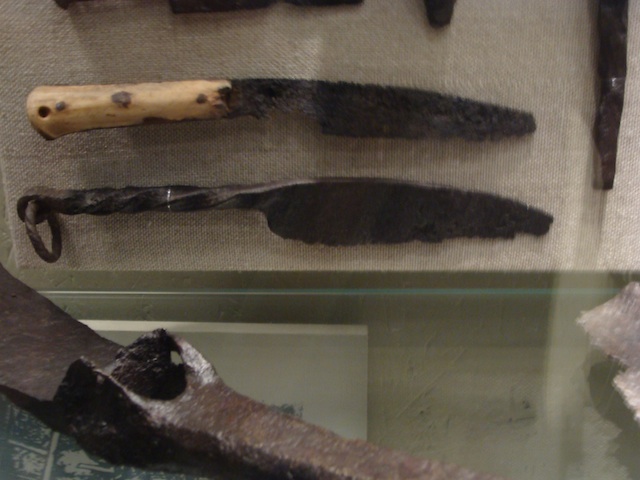Posts: 404 Location: Oxford, England
Thu 14 Oct, 2010 4:47 pm
Hello,
The discussion of women wearing belts is something I am less researched in. That being said I was under the impression it is slightly uncertain, and possible that belts were worn... but not all the time by every woman. I recall one saga in which a woman placed a belt/cord around her waist to make the dress show off her frame better. It shows two things... women wore belts but it was uncommon enough to take special note. I remember reading in an archeological journal that some women's graves contain tablet woven belts... but I am uncertain of the validity of this claim. If I recall it was from an older dig site (i.e. early 20th century). It was many years ago that I read this... and it was not something I took an especially keen interest in.
Pictured is a knife from a woman's grave. Now housed in Helsinki at the National Museum of Finland.
Cheers,
Hadrian
 Attachment: 39.05 KB
Attachment: 39.05 KB

Posts: 1,757 Location: Storvreta, Sweden
Thu 14 Oct, 2010 11:14 pm
I guess I could have been more clear:
In saying these are women´s knives I mean this:
Those knives that I have seen as identified parts of women accoutrements carried from chains (or woven bands?) from one of the twin fibulae (and you not *not* find these fibulae in men´s graves, unless you have cases of complete cross dressing, which is possible I guess: it would be interesting to hear about any examples of such!), these knives are all of similar type and size, made to be eye catching and elegant. They have the same metal mounts on the scabbard as the longer weapon knives that you find in some high status male graves (those that have these knives tend to also include horse gear as well as other weapons. There may be an odd unidentified woman among these men I guess, but the rule is these are men´s graves), so the types of knives found in women´s graves are almost miniature versions of these long knives.
So if we ask ourselves what kind of knife a viking woman might wear we can look at these grave finds knowing we see a selection of fine functional knives that are made to be carried in handy reach at all times, while at the same time firmly state the social standing of the woman, as the guardian of the locked door. The knives are made to look pretty, punched bronze catching the light, chains clinking and swaying with the movement of the body.
If there were knives carried by men that were similar is beside the point. The question was what kind of knife a woman might wear and this is pretty clear from archaeological evidence. In the viking house hold, I´m sure there were other knives and tools at hand, but we know that these types of knives were actually carried. They would have been markers of status and objects of beauty. Both functional and significant as female attributes.
Posts: 13 Location: Sweden
Fri 15 Oct, 2010 5:34 am
At this site,
http://www.ingruna.dinstudio.se/filearea_22.html
There's a PDF containing an article about them. It appears as they did indeed exist, at least in Denmark.
Posts: 12
Fri 15 Oct, 2010 6:29 am
While not necessarily a "Viking" grave, the woman's grave that was excavated in the 1980's at Peel Castle in the Isle of Man is specifically a 10th century grave of a wealthy middle-aged female. On a tablet woven belt (or sash) she carried a small knife with a wooden handle, a pair of scissors and a bone comb. Norse people lived in the area at this time, but as this burial did not have the traditional paired broaches, we do not know if this was a Scandinavian woman or not. She was also buried with a beautiful bead necklace, a couple of large amber beads, a cooking spit, and a sewing kit and several other items. Interestingly, she was buried with a second knife (that was apparently worn on the back of her belt), about 8" overall in length, with a clip point (saex?), the handle decorated with twisted silver wire. This second knife was carried in some kind of leather sheath.
Posts: 37 Location: Mexico
Sun 24 Oct, 2010 10:07 am
Look, according to my knowledge this knife if it is historical, here in Mexico my friend Ismael forges one very beautiful he looks you that well am him
[ Linked Image ]
Posts: 530
Sun 24 Oct, 2010 11:01 pm
| Luis Armando wrote: |
| Look, according to my knowledge this knife if it is historical, here in Mexico my friend Ismael forges one very beautiful he looks you that well am him |
Well the thing is thast many smiths make more or less beautefull versions of such knife, it's historical promenance was what we were trying to establish here - and so far it seems that it has nothing at all to do with the Viking age.
Posts: 404 Location: Oxford, England
Sat 05 Feb, 2011 12:27 am
Hello,
I have always disliked these knives, having never seen anything to give credence to their existence. That being said, I was looking through some of my photos the other day when I came across images of two knives of this style. Neither one is Viking nor attributed to a woman...
The knives are both from small Eastern European museums. Small Eastern European museums tend to have many fakes, or mislabeled items so that should be kept in mind.
The one with the number 8 beside it and red back ground was labeled simply as "Medieval Knife"
The other was labeled "XIV Century Knife"
Food for thought,
Hadrian
 Attachment: 79.06 KB
Attachment: 79.06 KB

 Attachment: 92.87 KB
Attachment: 92.87 KB

 Attachment: 84.07 KB
Attachment: 84.07 KB

Posts: 101
Mon 07 Feb, 2011 3:55 am
I have always wondered a bit about the assumption that viking women didn't wear belts. Why would this not be practical? Indeed they could probably hang a couple of doodads and show pieces from their brooches, but one would certainly not wear your best jewelry in your daily household grind. I'm going to guess this is based upon lacking belt pieces in female graves. A textile sash would however be both probable and decorative (but I don't want to base my argumentation on that last addition). Certainly it would be nice to have your stuff close by while working around in half-darkened house.
| Jeff Del Vecchio wrote: |
| While not necessarily a "Viking" grave, the woman's grave that was excavated in the 1980's at Peel Castle in the Isle of Man is specifically a 10th century grave of a wealthy middle-aged female. On a tablet woven belt (or sash) she carried a small knife with a wooden handle, a pair of scissors and a bone comb. Norse people lived in the area at this time, but as this burial did not have the traditional paired broaches, we do not know if this was a Scandinavian woman or not. She was also buried with a beautiful bead necklace, a couple of large amber beads, a cooking spit, and a sewing kit and several other items. Interestingly, she was buried with a second knife (that was apparently worn on the back of her belt), about 8" overall in length, with a clip point (saex?), the handle decorated with twisted silver wire. This second knife was carried in some kind of leather sheath. |
Posts: 10 Location: Finland
Thu 17 Feb, 2011 7:13 am
Hello Artis! We discussed this in Pukkisaari, if am not wrong? To your original question, I would like to comment, that the form of the knife in your picture is easy and fast to make from single piece of steel or iron. This is why it is so popular whith all sorts of blacksmiths selling their handicrafts at markets today. However, if the blade is soposed to keep its keennes, that one would expect from a tool knife, a knife should be made of steel. The kind of knife you posted would take more steel than a model that has handle made from organic material. And steel was a wery valuable commodity in the iron age. So what the blacksmith of viking era would have saved in time by making such a knife, by not preparing a handel from organic material, he would have surely lost by selling such a quantity of steel in the handle. Of course he could have forge welded the steel blade to a iron handle, but that again would be spending a lot of time to produce something that is more easily made and more ergonomic to use, if made from wood or bone.
There is one find of a knife of this shape from Finland. It is a lot smaller than the ones sold at markets and made out of bronze. It has a narrow spiralling handle and it was found in a grave that had goods usually connected to male burials. If I recall correctly, it was suggested to be a knife to trim the beard. Apparently because, being bronze it had remained a keen thin blade.
Posts: 530
Thu 17 Feb, 2011 7:24 am
Yes, Jaani, that we did :) and welcome to the forums! I never doubted that it is easy to make - I originally asked the question because one of ladies from our group asked about possibility of making such a knife for her - so I wanted to make sure if it would have been appropriate or not, and I am rather glad that overall responses indicate that my initial assessment was correct.
Posts: 10 Location: Finland
Thu 17 Feb, 2011 7:36 am
I thought that you were on the map whith this thing all a long. I just thought that what we discussed should be also posted to the conversation here. Thanks for welcoming me.
Posts: 250
Thu 23 Jun, 2011 3:34 pm
I came across something that I thought you folks might find interesting:
http://www.youtube.com/watch?v=CY8L1MCsiP4
The knife in this video is seen first at 1:27 and again in better detail in the next few seconds. It was found in a woman's grave from the Iron Age in Denmark. It's handle is straighter, but bears a striking resemblance to the knives in question. I don't know what museum it's in but maybe someone here will recognize it.
Posts: 793 Location: Stockholm, Sweden
Mon 27 Jun, 2011 9:02 am
| Artis Aboltins wrote: |
Well my extremely limited understanding of that language suggests that he claims the finds are 2000 years old or older? That would definitelly put it all WAY before Viking age :) |
The work refers to late pre-roman iron age. It being a scandinavian work I expect this refers to the span 200 BC- year 0. Interesting that such knives indeed existed at some point in history in scandinavia and are not works of fiction. But they're not from the viking age.
You
cannot post new topics in this forum
You
cannot reply to topics in this forum
You
cannot edit your posts in this forum
You
cannot delete your posts in this forum
You
cannot vote in polls in this forum
You
cannot attach files in this forum
You
can download files in this forum



